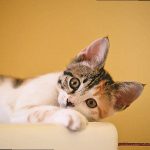Have you ever walked into the bathroom only to find your elderly cat sitting in their litter box? It’s a strange and unsettling sight, leaving you wondering what could be causing this behavior. But fear not, there are a few reasons why your feline friend might be doing this.
As cats age, they’re more susceptible to physical and cognitive changes that can affect their behavior. Urinary issues are a common cause for an elderly cat to sit in their litter box. Older cats are prone to urinary tract infections, kidney disease, and incontinence which can cause discomfort and lead to accidents in the litter box. Sitting in the box can provide some relief and help them feel more secure while they wait for their next trip outside.
Another reason for this behavior is anxiety or stress. Changes in their home environment such as new pets, visitors or changes in routine can make your cat feel anxious and insecure. Sitting in their litter box may provide them with a sense of comfort and familiarity.
It’s important to keep an eye on your elderly cat’s behavior and take note of any changes in their litter box habits. If your cat is spending an unusually long time in their box or showing other signs of discomfort or distress, it’s best to consult with a veterinarian to rule out any underlying medical issues.
So don’t fret if you catch your senior kitty lounging in their litter box. With some love and attention from you, they’ll be back to their usual selves soon enough.
What is Cognitive Dysfunction Syndrome (CDS)?
As cats age, their brain function declines, and this can lead to changes in their behavior. Cognitive Dysfunction Syndrome (CDS), also known as feline dementia, is a common condition in elderly cats that affects their cognitive abilities, including memory, learning, and awareness. CDS manifests through a range of symptoms such as confusion, disorientation, changes in sleep patterns, increased vocalization, loss of appetite, and changes in litter box behavior.
It’s crucial to note that not all elderly cats will develop CDS or show the same severity of symptoms. However, any changes in your cat’s behavior should be taken seriously and addressed with your veterinarian to rule out any underlying medical conditions.
While there is no cure for CDS, there are various management strategies that can help improve your cat’s quality of life. One of the simplest and most effective ways is to provide environmental enrichment for your cat. Stimulating your furry friend’s mind with puzzle feeders or toys helps keep them active and engaged.
Additionally, dietary changes or medication may be required to manage any underlying medical conditions contributing to your cat’s symptoms. For instance, if your cat is experiencing bowel issues, your vet may recommend a special diet or medication to alleviate their discomfort.
Signs and Symptoms of CDS in Cats
As our feline companions grow older, it’s natural for their bodies and minds to slow down. However, when your once-vibrant cat starts showing signs of confusion and forgetfulness, it could be an indication of Cognitive Dysfunction Syndrome (CDS), commonly known as feline dementia. CDS can be quite distressing for both the cat and its owner, but recognizing the signs and symptoms is the first step in managing the condition.
One of the most noticeable signs of CDS is changes in litter box habits. You may find your elderly cat sitting in their litter box, seemingly forgetting what it’s used for or where it’s located. Other behavioral changes include confusion, disorientation, and forgetfulness. Your cat may wander aimlessly around the house, become stuck in corners or under furniture, or even forget where their food and water bowls are.
Furthermore, sleep patterns may also be affected by CDS. Your once-active cat may sleep more during the day and become restless at night. They may also become more vocal than usual, crying out at night or meowing excessively.
As a responsible pet owner, it’s crucial to recognize these signs and symptoms and take action by scheduling an appointment with your veterinarian for a proper diagnosis and treatment plan. There are medications available that can help improve your cat’s quality of life by slowing down the progression of CDS.
Besides medication, providing environmental enrichment through toys and puzzles can also help stimulate your cat’s brain and improve cognitive function. Changes in diet or medication to manage underlying medical conditions can also make a significant difference.

Causes of Urinary Tract Infections (UTI) in Cats
Urinary tract infections (UTIs) are a common health problem that many cats face, especially as they age. These infections occur when bacteria enter and infect the urinary tract, including the bladder, urethra, ureters, and kidneys. As a cat owner, it’s important to understand the potential causes of UTIs so that you can take steps to prevent them.
One of the primary reasons why elderly cats are more prone to UTIs is due to their weakened immune systems. As cats age, their immune systems become less effective at fighting off infections, allowing bacterial overgrowth in the urinary tract. Moreover, underlying health conditions such as diabetes or kidney disease can weaken their immune system even further.
Bladder dysfunction is another factor that can contribute to UTIs in elderly cats. As cats age, their bladder muscles may become weaker or less responsive, making it difficult for them to empty their bladders fully. This creates an environment where bacteria can thrive and cause infections.
Dehydration, kidney stones or crystals, and certain medications that alter the pH balance of the urine can also cause UTIs in cats. Female cats are particularly susceptible to UTIs due to their shorter urethras which allow bacteria easier access to the urinary tract.
If you suspect that your elderly cat may have a UTI, it’s crucial to take them to the vet as soon as possible. Left untreated, UTIs can be painful and potentially dangerous for your cat’s health. Signs of a UTI include frequent urination, straining in the litter box, blood in the urine, and urinating outside of the litter box.
Prevention is key when it comes to UTIs in cats. Encouraging your cat to drink plenty of water, providing a clean litter box, and feeding them a healthy diet can all help keep their urinary tract healthy. Additionally, regular check-ups with your veterinarian can help catch any potential health issues before they become more serious.
Signs and Symptoms of UTIs in Cats
UTIs are a common health issue among cats, but they can be especially prevalent in elderly felines. As cats age, their immune system weakens, and the risk of developing UTIs increases. Unfortunately, the signs and symptoms of UTIs in cats can be subtle and easily missed by cat owners. Therefore, it’s essential to stay vigilant for any potential warning signs.
The most common symptoms of UTIs in cats include frequent urination, difficulty urinating, blood in urine, strong-smelling urine, and urinating outside the litter box. Cats with UTIs may also experience pain while urinating and show signs of discomfort such as meowing or crying while using the litter box. However, some cats with UTIs may not display any symptoms at all, making it difficult for pet owners to detect a problem.
Therefore, regular veterinary check-ups are critical for maintaining your cat’s overall health. A veterinarian can perform a physical examination and run diagnostic tests such as a urinalysis to confirm the diagnosis and rule out other possible health issues. Early detection is crucial since untreated UTIs can lead to serious complications such as kidney damage or death.
Preventing UTIs in cats is possible by taking preventative measures. Ensure that your cat has access to clean litter boxes and encourage hydration by providing fresh water and wet food. Also, feeding a healthy diet that supports urinary tract health can reduce the risk of developing UTIs.
How to Diagnose a UTI in Your Cat
As your beloved feline friend ages, it becomes more crucial to pay close attention to their health and behavior. One common health problem in elderly cats is a urinary tract infection (UTI), which can cause discomfort and pain if left untreated. In this article, we will delve deeper into how to diagnose a UTI in your elderly cat by breaking it down into five sections.
Know the Symptoms:
The first step in diagnosing a UTI in your elderly cat is recognizing the signs and symptoms. Some of these symptoms include urinating outside the litter box, frequent urination, straining to urinate, blood in the urine, and foul-smelling urine. If you notice any of these symptoms, it’s essential to take your cat to the veterinarian as soon as possible.
Physical Examination:
Once at the vet’s office, the vet will perform a physical examination on your cat. They may also collect a urine sample for analysis. The urine sample will be examined for the presence of bacteria or white blood cells, which are indicators of a UTI.
Blood Tests and Imaging Tests:
In some cases, the vet may also perform blood tests or imaging tests to rule out other underlying health issues that may be causing your cat’s symptoms. These tests can help provide a more accurate diagnosis of your cat’s condition.
Observe Your Cat’s Behavior:
Observing your cat’s behavior and habits is another vital component of diagnosing a UTI. If you notice that your cat is frequently visiting the litter box but not producing urine or vocalizing when urinating or licking their genitals excessively, it could be a sign of a UTI.
Preventative Measures:
Preventing UTIs in elderly cats is crucial due to their weakened immune systems and other age-related health problems. Providing your cat with plenty of fresh water, feeding them a balanced and nutritious diet, and ensuring they have access to clean litter boxes are some preventative measures that pet owners can take. Regular check-ups with your veterinarian can also help identify any potential health issues before they become severe.
Causes of Constipation in Elderly Cats
As your beloved feline companion ages, their bowel movements can become a cause for concern. Constipation is a common problem among elderly cats, with several possible causes that pet owners should be aware of.
One of the leading causes of constipation in senior cats is dehydration. As cats age, they may experience changes in their senses of smell and taste, or mobility issues that make accessing water more challenging. As a result, they may not drink enough water, leading to dry feces that are difficult to pass. To address this issue, it’s essential to ensure your cat has plenty of water available and provide wet food as part of their diet.
Lack of exercise can also contribute to constipation in elderly cats. Mobility issues can make it difficult for older cats to move around or access litter boxes with high sides. Encouraging your cat to exercise through playtime and providing lower-sided litter boxes can help improve their bowel movements.
Finally, a diet lacking in fiber can lead to constipation in older cats. Many commercial cat foods are low in fiber, which can cause irregular bowel movements. To prevent this problem, ensure that your cat’s diet includes enough fiber to promote regular bowel movements. You can ask your veterinarian for recommendations on fiber supplements or specialized diets to help address this issue.
Signs and Symptoms of Constipation in Elderly Cats
As your feline companion enters their golden years, you need to be more vigilant about their poop habits. Constipation in elderly cats is a common health problem that can lead to severe health issues if left untreated. To ensure your furball stays healthy and happy, it’s crucial to recognize the signs and symptoms of constipation in elderly cats.
The first telltale sign that your cat may be constipated is infrequent bowel movements. If you notice that your cat isn’t having regular bowel movements, it could be a sign of constipation. Keep a record of how often they go and if there are any changes in frequency.
Another symptom of constipation in elderly cats is straining to defecate. You might notice your cat squatting in the litter box for an extended period without producing any stool. Additionally, if your cat’s stool is small, hard, and dry, it could be difficult for them to pass, leading to constipation.
Loss of appetite is another signal of constipation in elderly cats. If they’re not eating well or drinking enough water, they could become dehydrated, which can worsen constipation. Lethargy is also a common symptom – if your cat isn’t as active as usual, it could indicate that they’re experiencing discomfort due to constipation.
Finally, frequent vomiting or difficulty keeping food down could be a sign of severe constipation. If you witness any of these symptoms in your elderly cat, it’s crucial to take them to the vet as soon as possible.
To maintain your cat’s health and wellbeing, keep an eye out for the signs and symptoms of constipation in elderly cats. Seek veterinary care immediately if you suspect that your furry friend is suffering from constipation. With proper treatment and care, you can help ensure that your cat’s bowel movements remain as smooth as silk, allowing them to live their best life in their golden years.
In summary, here’s a quick checklist of the signs and symptoms of constipation in elderly cats:
- Infrequent bowel movements
- Straining to defecate
- Small, hard, and dry stools
- Loss of appetite
- Lethargy
- Frequent vomiting or difficulty keeping food down
Treatment Options for Urinary Tract Infections and Constipation in Elderly Cats
Unfortunately, urinary tract infections (UTIs) and constipation are common ailments that can cause pain and discomfort in elderly cats. It’s important to recognize the symptoms and seek veterinary care immediately. But what are the treatment options for these conditions?
Luckily, there are several options available to help alleviate the symptoms of UTIs and constipation in your senior cat. Your veterinarian may prescribe antibiotics or laxatives, depending on the diagnosis. Hospitalization may also be necessary if your cat is severely dehydrated or unable to urinate.
In addition to medication, there are many at-home remedies you can try to help your cat feel better. One effective treatment for UTIs is increasing their water intake by providing fresh, clean water at all times. Wet food can also help increase hydration levels. For constipation, fiber-rich foods like canned pumpkin or psyllium husk powder can regulate bowel movements.
Prevention is always the best course of action when it comes to your cat’s health. A balanced diet, regular exercise, and clean water access can help prevent UTIs and constipation from occurring in the first place. Regular check-ups with your vet can also catch any potential health concerns early on.
Conclusion
As your beloved feline friend ages, it’s natural to become more vigilant about their behavior. One peculiar habit that may cause alarm is finding them sitting in their litter box. But before you hit the panic button, it’s crucial to understand that there are several reasons why they might be doing this.
Urinary issues are a common culprit for this behavior, with older cats being more susceptible to urinary tract infections, kidney disease, and incontinence. Additionally, anxiety or stress caused by changes in their environment can also trigger this behavior.
Cognitive Dysfunction Syndrome (CDS), also known as feline dementia, is another condition that affects elderly cats’ cognitive abilities such as memory and awareness. Symptoms include confusion, disorientation, and changes in sleep patterns and litter box habits.
Other health problems that can lead to your senior cat sitting in their litter box include constipation and dehydration. UTIs occur when bacteria infect the urinary tract, while constipation can result from a lack of exercise or fiber-rich foods.
It’s crucial to recognize the signs and symptoms of these conditions promptly so you can seek veterinary care immediately. Treatment options range from medication to at-home remedies such as increasing water intake or providing fiber-rich foods.
Prevention is always better than cure when it comes to your cat’s health. Ensure they have access to clean water, a balanced diet rich in nutrients, regular exercise routines, and regular check-ups with your vet.







